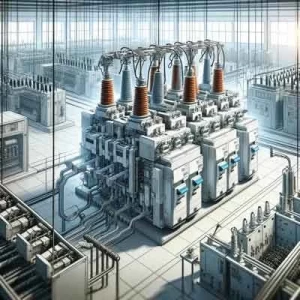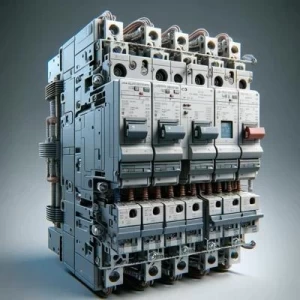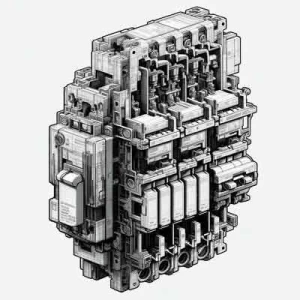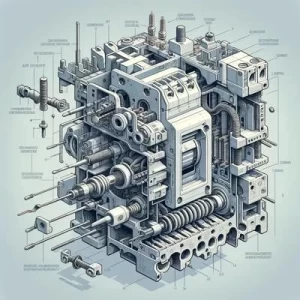A Deep Dive into Air Circuit Breakers
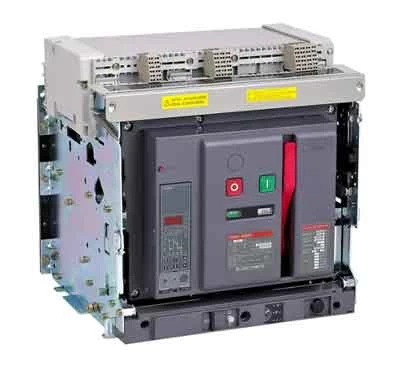
In the intricate world of power distribution, a silent sentinel stands guard - the air circuit breaker (ACB). Often overshadowed by its flashier counterparts like transformers and generators, ACBs play a critical role in ensuring the smooth flow of electricity. These workhorses function as guardians, swiftly interrupting current during faults (abnormalities) to protect equipment and prevent widespread outages.
This article delves into the world of ACBs, exploring their intricate workings, operational principles, and the advantages that make them a cornerstone of reliable power distribution.
Demystifying the ACB: A Look Inside
The robust exterior of an ACB houses a symphony of meticulously designed components, each contributing to its lifesaving function:
Outer Casing: This sturdy enclosure, typically crafted from epoxy resin or high-grade porcelain, serves several crucial purposes:
Mechanical Protection: Safeguarding the internal components from external impacts and environmental factors.
Electrical Insulation: Preventing current leakage and ensuring safe operation by offering high electrical resistance.
Arc Quenching Chamber: Housing the mechanism responsible for extinguishing the arc during fault interruptions.
Moving and Fixed Contacts: These contacts form the heart of the switching mechanism:
Fixed Contact: This stationary element remains fixed within the chamber and serves as the entry point for the incoming current.
Moving Contact: This movable component, connected to the operating mechanism, establishes or breaks the electrical connection with the fixed contact, controlling the current flow.
Arc Chute: This crucial component aids in containing and directing the intense heat and light generated during contact separation, facilitating its rapid extinction.
Operating Mechanism: This mechanism, either manual for low voltage applications or electrically operated for medium and high voltage applications, transmits the control signal to the moving contact, enabling the opening and closing of the breaker based on various control methods.
Bellows: These flexible, airtight connections allow movement of the operating mechanism while maintaining the integrity of the enclosure, preventing air from entering the arc quenching chamber.
The Power of Air: Arc Interruption and Protection
Unlike its counterparts that utilize oil or vacuum for arc interruption, ACBs rely on the inherent properties of air at atmospheric pressure:
Limited Arc Formation: The relatively low density of air within the chamber hinders the formation and sustenance of an electrical arc, minimizing its occurrence and potential damage.
Rapid Arc Quenching: When an arc does form during contact separation, the surrounding air acts as an insulating medium, rapidly extinguishing it and effectively stopping the flow of current.
Arc Chute Assistance: The design of the arc chute further aids in directing and extinguishing the arc by utilizing the air blast created during contact separation. This air blast cools and stretches the arc, ultimately extinguishing it.
Beyond the Basics: Advantages and Applications
ACBs offer a compelling combination of benefits that make them a popular choice in various applications:
High Interrupting Capacity: These breakers excel at interrupting large fault currents (abnormal surges in electricity), making them ideal for protecting equipment and preventing widespread outages in medium voltage (MV) applications, typically ranging from 3.3kV to 33kV.
Compact Design: Compared to some alternative options, ACBs offer a more compact and space-efficient design, facilitating easier installation and maintenance in substations and other critical infrastructure. This is particularly beneficial in situations where space is a premium.
Lower Maintenance Requirements: Unlike oil circuit breakers (OCBs) that require regular maintenance due to arcing during operation, ACBs benefit from the air environment. This significantly reduces maintenance needs and associated costs, as there's no need for oil replacement or disposal.
Environmentally Friendly: ACBs eliminate the environmental concerns associated with OCBs, such as potential oil leaks and disposal challenges, making them a more sustainable option. Additionally, the air used for arc quenching is readily available and does not pose any environmental hazards.
Beyond the Textbook: Real-World Applications
ACBs find application in a wide range of electrical systems, including:
Medium Voltage Distribution: Protecting transformers, feeders, and motors in industrial plants, commercial buildings, and utility distribution networks.
Power Plants: Safeguarding auxiliary equipment and generators within power generation facilities.
Renewable Energy Integration: Providing protection for wind and solar farms, ensuring grid stability and preventing damage during faults.
Marine Applications: ACBs are often utilized on ships and offshore platforms due to their compact size, lower maintenance requirements, and ability to withstand harsh marine environments.
Balancing Advantages with Limitations: Considerations for Implementation
While ACBs offer a compelling array of benefits, it's important to consider their limitations when making informed decisions about their implementation:
Higher Initial Cost: Compared to some alternatives, ACBs generally have a higher initial cost. However, their lower maintenance requirements can help offset this difference over time. Additionally, advancements in manufacturing processes may lead to a decrease in their initial cost in the future.
Limited Current Ratings: While offering superior interrupting capacity compared to standard low voltage breakers, ACBs typically have lower current ratings than some specialized high voltage breakers. This restricts their use in specific high current applications, such as high-voltage transmission lines where immense current flows require specialized breakers with even higher interrupting capacities.
Arc Blast Potential: During fault interruptions, ACBs can generate an arc blast that, if not managed effectively, could pose potential damage to surrounding equipment. Modern designs incorporate features like arc chutes and blast chambers to minimize this risk, but it's still a crucial factor to consider during installation and operation.
The Future of Air Circuit Breakers: Embracing Innovation
The future of ACBs seems bright, with ongoing research and development efforts focused on further improving their performance and addressing existing limitations. Here are some potential areas of exploration:
Enhanced Arc Quenching Techniques: Researchers are exploring novel materials and innovative arc quenching chamber designs to improve arc extinction efficiency and minimize arc blast, leading to even safer and more reliable operation.
Smart Breaker Integration: Integrating advanced sensors and communication capabilities into ACBs can enable real-time monitoring of operational parameters, fault detection, and remote control, contributing to smarter and more efficient grid management. This can facilitate predictive maintenance and quicker response times during faults.
Material Advancements: Utilizing new materials with superior insulating properties and enhanced thermal resistance can potentially allow ACBs to handle higher current ratings and operate at higher temperatures, expanding their application possibilities and potentially enabling their use in high voltage transmission applications.
Sustainability Focus: Exploring eco-friendly alternatives for manufacturing materials and developing efficient recycling processes for end-of-life ACBs can further enhance their environmental sustainability profile.
Evolving for the Future
Air circuit breakers serve as crucial components within the power grid, safeguarding equipment and maintaining stability through their efficient fault interruption capabilities. Understanding their construction, principles of operation, advantages, and limitations is essential for appreciating their role and selecting the most appropriate breaker for specific applications. As technology advances, ACBs are poised to evolve further, offering enhanced performance, improved sustainability, and potentially wider applicability within the ever-evolving realm of power distribution. Their significance as unsung heroes of the power grid is undeniable, and their future holds promise for continued innovation that ensures the safe and reliable flow of electricity for generations to come.

